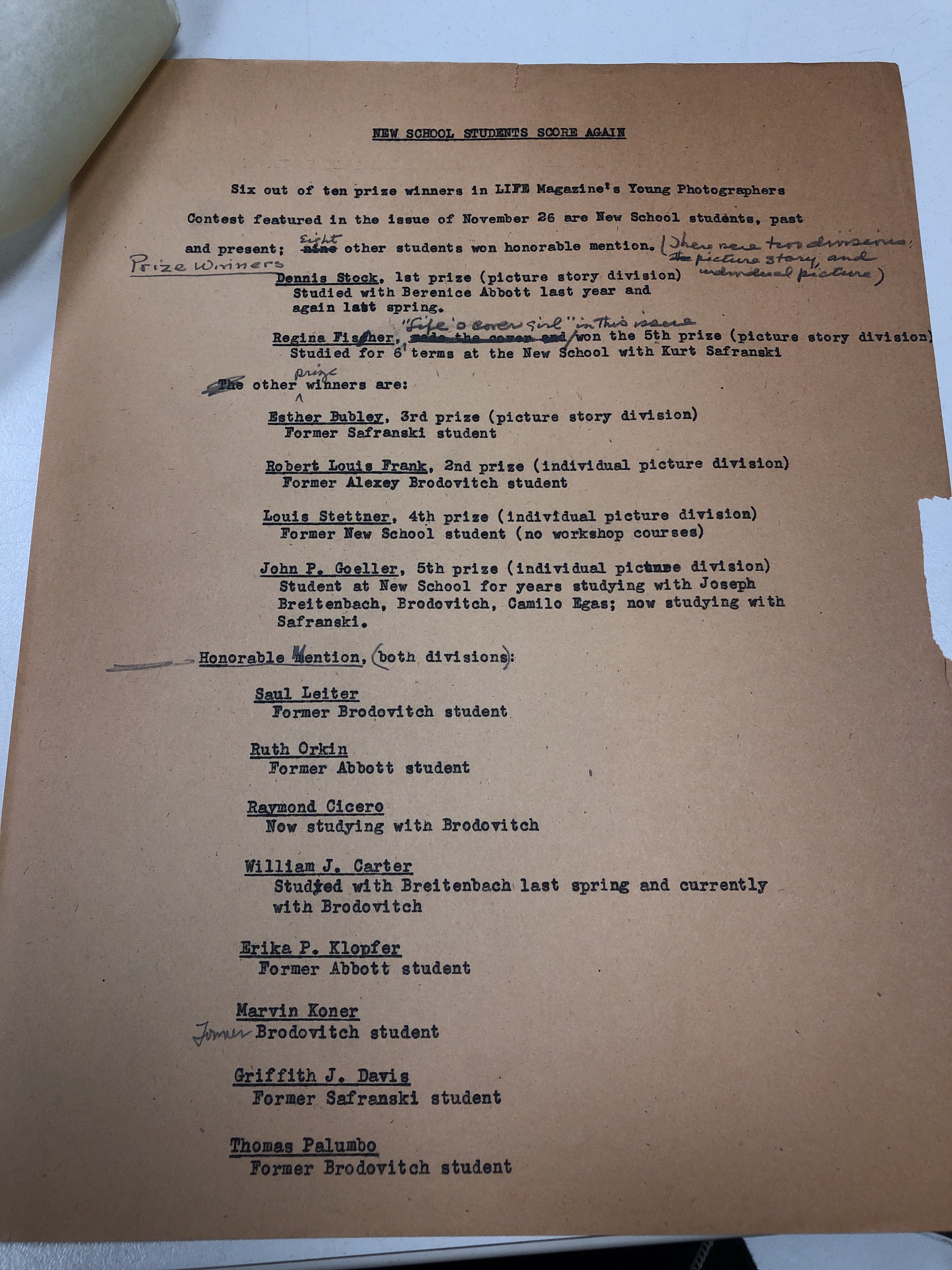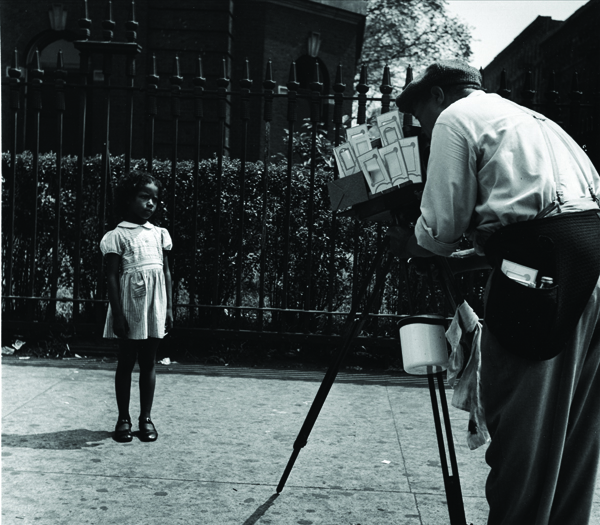Archive
Erika Stone
- Erika
- Stone
Erika Klopfer
- 29-06-1924
- Frankfurt am Main (DE)
- Photographer
Erika Stone is a German émigré, who moved to New York with her parents and sister in December 1936, at the age of 12. She went on to carve out a career as photographer.
Word Count: 32

Portrait of Erika Stone, 1951 (© Erika Stone, Courtesy of Katarina Doerner Photographs, Brooklyn, NY). 
Letter in which Erika Stone (Klopfer) is honoured as photo contest winner for Life magazine, November 1926, 1951 
Erika Stone, Bowery Beauties, New York, 1946 ( © Erika Stone, Courtesy of Katarina Doerner Photographs, Brookly, NY). 
Erika Stone, Harlem Street Photographer, NYC, ca. 1950 ( "Lot 182: Erika Stone" by sfcamerawork is licensed under CC BY-NC-SA 2.0). Bonanos, Christopher. Flash. The Making of Weegee the Famous. Henry Holt and Company, 2018.
Displaced Visions. Émigré Photographers of the 20th Century, edited by Nissan N. Perez, exh. cat. The Israel Museum, Jerusalem, 2013.
Faye, Helen. Picture Sources: An introductory list. Special Libraries Association, 1959.
Ganahl, Rainer. "Language of Emigration / Sprache der Emigration: Erika Stone." Interview, 27 November 1999, New York, ganahl.info. Accessed 4 Max 2021.
Gilbert, George. The Illustrated Worldwide Who’s Who of Jews in Photography. G. Gilbert, 1996.
Korbut, Sasha. “Erika Stone. A Moment that Lasted a Century” (Interview with Erika Stone, February 2015). Sasha Korbut. Accessed 5 February 2021.
Stone, Erika. Pro-Techniques of Photographing Children. HP Books, 1986.
Roth, Helene. “The Bar Sammy’s Bowery Follies as Microcosm and Photographic Milieu Study for Emigrated European Photographers in 1930s and 1940s New York.” Arrival Cities. Migrating Artists and New Metropolitan Topographies in the 20th century, edited by Burcu Dogramaci et al., Leuven University Press, 2020, pp. 293–313. OAPEN. Accessed 1 March 2021.
Stone, Erika. “Es war ein Schock für mich als wir erfuhren, daß wir jüdisch sind.” Emigranten in New York, edited by Ellen Küppers, Klaus Boer,1995, pp. 33–47.
Stone, Erika. Mostly People. Fotografien einer deutschen Emigrantin in New York, edited by Sibylle Appuhn-Radtke and Helmut Heß, exh. cat. Zentralinstitut für Kunstgeschichte, Munich, 2001.
Stone, Erika. Especially People. Einfach Menschen. Photographien – Photographs. Gryphon Verlag, 2004.
Unbelichtet. Münchner Fotografen im Exil, edited by Tatjana Neef, exh. cat. Jüdisches Museum München, Munich, 2010.
Word Count: 232
New York, US (1936).
Riverdale, The Bronx (residence, 1936–?); 474 West 238th Street, The Bronx, New York City (1950–?); 160 East 48st Street, Yorkville, New York City (residence and workplace, 1950s); 327 East 82st Street, Turtle Bay, New York City (residence and workplace, 1980s/1990s); 455 North End Avenue, Tribeca, New York City (2007).
- New York
- Helene Roth. "Erika Stone." METROMOD Archive, 2021, https://archive.metromod.net/viewer.p/69/2948/object/5138-8103248, last modified: 23-08-2021.
-
Kurt SafranskiPicture AgentFounding MemberTeacherCartoonistPublisherIllustratorNew York
Kurt Safranski was one of the founding members of the Black Star photo agency, a teacher at the New School for Social Research and the author of photojournalistic articles and books.
Word Count: 31
Lisette ModelPhotographerNew YorkLisette Model was an Austrian-born photographer who lived in New York with her husband Evsa Model after emigrating from France. Her street photographs capturing the curiosities of everyday life quickly caught the interest of museums and magazines.
Word Count: 37
Charles LeirensPhotographerMusicianMusicologistNew YorkCharles Leirens was a Belgian-born musician and photographer who emigrated to New York in 1941. While publishing two books on Belgian music, he also gave courses in musicology and photography at the New School for Social Research.
Word Count: 36
Marion PalfiPhotographerNew YorkMarion Palfi was a German émigré photographer who lived in New York from the 1940s to the 1960s. Her photographic engagement in social and political topics made her name for her use of the camera to draw attention to social injustices.
Word Count: 41
Tim GidalPhotographerPublisherArt HistorianNew YorkTim Gidal was a German-Jewish photographer, publisher and art historian emigrating in 1948 emigrated to New York. Besides his teaching career, he worked as a photojournalist and, along with his wife Sonia Gidal, published youth books.
Word Count: 35
Ruth StaudingerPhotographerCinematographerArt dealerNew YorkVery few and only fragmentary details can be found on the German émigré photographer Ruth Staudinger, who emigrated in the mid-1930s to New York City. Her nomadic life was also characterisedd by several changes of name along the way.
Word Count: 40
Trude FleischmannPhotographerNew YorkTrude Fleischmann was an Austrian-Jewish portrait and dance photographer who emigrated in 1939 to New York, where she opened a studio in Midtown Manhattan with the photographer Frank Elmer.
Word Count: 28
Leco Photo ServicePhoto LabNew YorkLeco Photo Service was a photofinishing lab, highly-frequented and a contact hub for émigré photographers and photo agencies during the 1930s and 1940s, as well as a provider of employment for women in the photo industry.
Word Count: 36
New School for Social ResearchAcademy/Art SchoolPhoto SchoolUniversity / Higher Education Institute / Research InstituteNew YorkDuring the 1940s and 1950s emigrated graphic designers and photographers, along with artists and intellectuals, were given the opportunity to held lectures and workshops at the New School for Social Research.
Word Count: 31
Photo-RepresentativesPhoto AgencyNew YorkPhoto-Representatives was a photo agency founded by the photographers Erika Stone and Anita Beer in 1953.
Word Count: 15
European Picture ServicePhoto AgencyNew YorkThe European Picture Service was a photo agency located in Midtown Manhattan founded, probably in 1930, by the émigré photographer Max Peter Haas (1901–1985).
Word Count: 22
Werner WolffPhotographerNew YorkWerner Wolff was forced to leave Germany in 1936 due to his Jewish background and emigrated via Hamburg to New York, where he could follow his career as photographer and photojournalist.
Word Count: 30
Ernest NashPhotographerArchaeologistLawyerNew YorkErnest Nash was a German born photographer, who pursued his photographic as well as an archeologic interest in Roman architecture after his emigration to New York in 1939. Besides this research interest, he also worked as a portrait photographer and publisher.
Word Count: 40
Ellen AuerbachPhotographerNew YorkWhen she arrived in New York in 1937, the German-born photographer Ellen Auerbach (formerly Rosenberg) had already passed through exile stations in Palestine and Great Britain.
Word Count: 25
Lilly JossPhotographerNew YorkLilly Joss was an émigré freelance photographer in New York. She worked for the Black Star photo agency and magazines and was also a portrait and theatre photographer.
Word Count: 28
Fritz HenlePhotographerNew YorkFritz Henle was a German Jewish photographer who emigrated in 1936 to New York, where he worked as a photojournalist for various magazines. He also published several photobooks of his travels throughout North America and Asia.
Word Count: 35